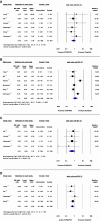Staged Percutaneous Intervention for Concurrent Chronic Total Occlusions in Patients With ST-Segment-Elevation Myocardial Infarction: A Systematic Review and Meta-Analysis
- PMID: 29654206
- PMCID: PMC6015413
- DOI: 10.1161/JAHA.117.008415
Staged Percutaneous Intervention for Concurrent Chronic Total Occlusions in Patients With ST-Segment-Elevation Myocardial Infarction: A Systematic Review and Meta-Analysis
Abstract
Background: Studies have shown that chronic total occlusion (CTO) in a noninfarct-related artery in patients with ST-segment-elevation myocardial infarction is linked to increased mortality. It remains unclear whether staged revascularization of a noninfarct-related artery CTO in patients with ST-segment-elevation myocardial infarction translates to improved outcomes. We performed a meta-analysis to compare outcomes between patients presenting with ST-segment-elevation myocardial infarction with concurrent CTO who underwent percutaneous coronary intervention of noninfarct-related artery CTO versus those who did not.
Method and results: We conducted an electronic database search of all published data. The primary end point was major adverse cardiovascular events. Secondary end points were all-cause mortality, cardiovascular mortality, myocardial infarction, repeat revascularization with either percutaneous coronary intervention or coronary artery bypass grafting, stroke, and heart failure readmission. Odds ratios (ORs) and 95% confidence intervals (CIs) were computed. Random effects model was used and heterogeneity was considered if I2 >25. Six studies (n=1253 patients) were included in the analysis. There was a significant difference in major adverse cardiovascular events (OR, 0.54; 95% CI, 0.32-0.91), cardiovascular mortality (OR, 0.43; 95% CI, 0.20-0.95), and heart failure readmissions (OR, 0.57; 95% CI, 0.36-0.89), favoring the patients in the CTO percutaneous coronary intervention group. No significant differences were observed between the 2 groups for all-cause mortality (OR, 0.47; 95% CI, 0.22-1.00), myocardial infarction (OR, 0.78; 95% CI, 0.41-1.46), repeat revascularization (OR, 1.13; 95% CI, 0.56-2.27), and stroke (OR, 0.51; 95% CI, 0.20-1.33).
Conclusions: In this meta-analysis, CTO percutaneous coronary intervention of the noninfarct-related artery in patients presenting with ST-segment-elevation myocardial infarction was associated with a significant reduction in major adverse cardiovascular events, cardiovascular mortality, and heart failure readmissions.
Keywords: ST‐segment–elevation myocardial infarction; chronic total occlusion; meta‐analysis; percutaneous coronary intervention.
© 2018 The Authors. Published on behalf of the American Heart Association, Inc., by Wiley.
Figures



References
-
- O'Gara PT, Kushner FG, Ascheim DD, Casey DE Jr, Chung MK, de Lemos JA, Ettinger SM, Fang JC, Fesmire FM, Franklin BA, Granger CB, Krumholz HM, Linderbaum JA, Morrow DA, Newby LK, Ornato JP, Ou N, Radford MJ, Tamis‐Holland JE, Tommaso CL, Tracy CM, Woo YJ, Zhao DX, Anderson JL, Jacobs AK, Halperin JL, Albert NM, Brindis RG, Creager MA, DeMets D, Guyton RA, Hochman JS, Kovacs RJ, Kushner FG, Ohman EM, Stevenson WG, Yancy CW. 2013 ACCF/AHA guideline for the management of ST‐elevation myocardial infarction: a report of the American College of Cardiology Foundation/American Heart Association Task Force on Practice Guidelines. J Am Coll Cardiol. 2013;61:e78–e140. - PubMed
-
- Roffi M, Patrono C, Collet JP, Mueller C, Valgimigli M, Andreotti F, Bax JJ, Borger MA, Brotons C, Chew DP, Gencer B, Hasenfuss G, Kjeldsen K, Lancellotti P, Landmesser U, Mehilli J, Mukherjee D, Storey RF, Windecker S; ESC Scientific Document Group . 2015 ESC guidelines for the management of acute coronary syndromes in patients presenting without persistent ST‐segment elevation: Task Force for the Management of Acute Coronary Syndromes in Patients Presenting Without Persistent ST‐Segment Elevation of the European Society of Cardiology (ESC). Eur Heart J. 2016;37:267–315. - PubMed
-
- Claessen BE, van der Schaaf RJ, Verouden NJ, Stegenga NK, Engstrom AE, Sjauw KD, Kikkert WJ, Vis MM, Baan J Jr, Koch KT, de Winter RJ, Tijssen JG, Piek JJ, Henriques JP. Evaluation of the effect of a concurrent chronic total occlusion on long‐term mortality and left ventricular function in patients after primary percutaneous coronary intervention. JACC Cardiovasc Interv. 2009;2:1128–1134. - PubMed
-
- Park DW, Clare RM, Schulte PJ, Pieper KS, Shaw LK, Califf RM, Ohman EM, Van de Werf F, Hirji S, Harrington RA, Armstrong PW, Granger CB, Jeong MH, Patel MR. Extent, location, and clinical significance of non‐infarct‐related coronary artery disease among patients with ST‐elevation myocardial infarction. JAMA. 2014;312:2019–2027. - PubMed
-
- van der Schaaf RJ, Vis MM, Sjauw KD, Koch KT, Baan J Jr, Tijssen JG, de Winter RJ, Piek JJ, Henriques JP. Impact of multivessel coronary disease on long‐term mortality in patients with ST‐elevation myocardial infarction is due to the presence of a chronic total occlusion. Am J Cardiol. 2006;98:1165–1169. - PubMed
Publication types
MeSH terms
LinkOut - more resources
Full Text Sources
Other Literature Sources

